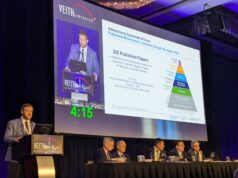Ice, cold and snow make it tough to walk outside in Lansing, Michigan, right now. So, jokes Doug Giller, he is wearing a path in his carpeting instead. For 45 minutes each evening, he walks a path throughout his house while watching television—all to keep up with his SVS Supervised Exercise Therapy (SET) app program.
The app, he said, “has been wonderful. I’d recommend it to anybody. And even when this program ends, I’ll continue to walk for the rest of my life.”
He’s always been a man on his feet, working 30 years for General Motors, and roller-skating several times a week. When attending his grandchildren’s sporting events, he’d deliberately park farther away to get a little exercise.
But then, one day, a sharp pain in his calf while walking to a ball field stopped him cold. When it continued, always in the same leg and always in the same spot, he went to the doctor. His cardiovascular surgeon told him he was a candidate for a stent, and then mentioned a program he’d been following in Europe that involved walking as a treatment for peripheral arterial disease (PAD). Giller was interested, but enrollment was full.
He began walking with his son, and the situation improved—“but I still wanted to get into that program!” he said. And, when he was admitted, he started on his own three weeks ahead of time. Misunderstanding the goal of walking five days a week, the self-described type A personality walked seven instead.
He likes all elements of the program, including the nutritional information and the daily messages that remind him to “go as hard as you can, but don’t hurt yourself.” One message in particular resonated: “You don’t have to be perfect.”
“That was the best one for me,” he said. “I don’t have to walk the same time every day. That helped me relax a bit.”
He called the leg pain a big wake-up call. “When I couldn’t walk a quarter-mile without hurting, that was a big signal to me,” he said. “I went from no pain to big pain.”
The prospect of surgery propels him forward. “If you tell me, ‘if you walk, you don’t have to do surgery,’ I’m going to walk. I know it’s minor surgery, but I don’t want it if I don’t have to have it. It’s been an incentive to get back in shape.”
He will return to his surgeon in June, and hopes to hear good news on a variety of markers. “I’m a results-driven person,” he said.
Beyond changing his diet and walking, he also makes sure to incorporate breaks from sitting every 15 to 20 minutes, as the program has suggested.
“It’s changed me,” he said. “Even when this program ends, I’ll continue to walk for the rest of my life. I have such a sense of accomplishment when I’m done. I feel energized.”












